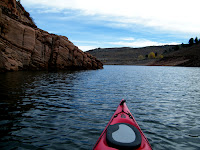The part of Prairie Creek that had always scared me the most was the Second Bridge. The first bridge is tall and holds Hawthorne Road above the creek. The second bridge is much smaller and supports the Gainesville-Hawthorne trail--and is much closer to the water, as in scraping-up-against-mud-dauber-wasp-nests closer. Thanks to a ornery mood before putting in, and near-record-low water levels, I was ready to shoot the gap, which I did without incident.
Prairie Creek on the other side of this bridge is another world altogether. The water goes from a milky jade to a cesspool brown. The creek itself narrows and become cluttered with tree falls and detritus. This paddler felt like he was entering the Heart of Darkness right there in Payne's Prairie. There was more to discover downstream, but after about 1/2 mile I turned around and headed back.
You will have to trust me when I say the picture above is of a water moccasin. I thought I had captured it but apparently my boat was about to collide with the selfsame tree said moccasin was chilling in. Hence, the shot of the water and the starboard side of my boat. One of the many scary things about water moccasins is they blend in so well with their surroundings. This one was akistrodon piscivorus conanti, the species associated with this area, and it looked like a muddy, muscle-bound walking stick. But the pit viper head was unmistakable. I want to go back and get a better shot of it.
Paddling back out into a uncharacteristically calm Newnan's was like walking into my own living room after an especially scary dream. The breeze can only be described as sweet and, as I was paying close attention, scented with the cypress that rings the lake. This is home.









































